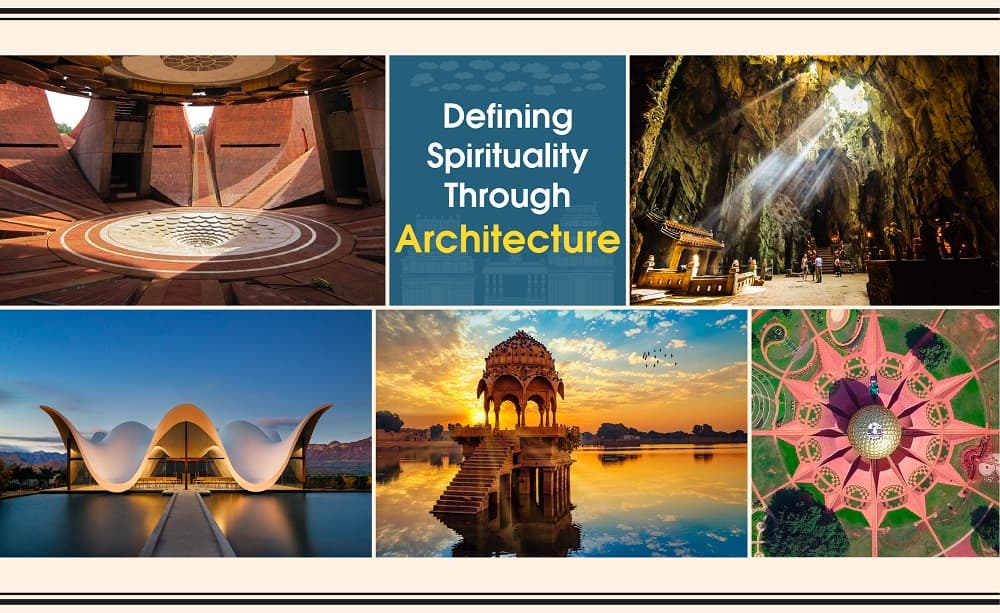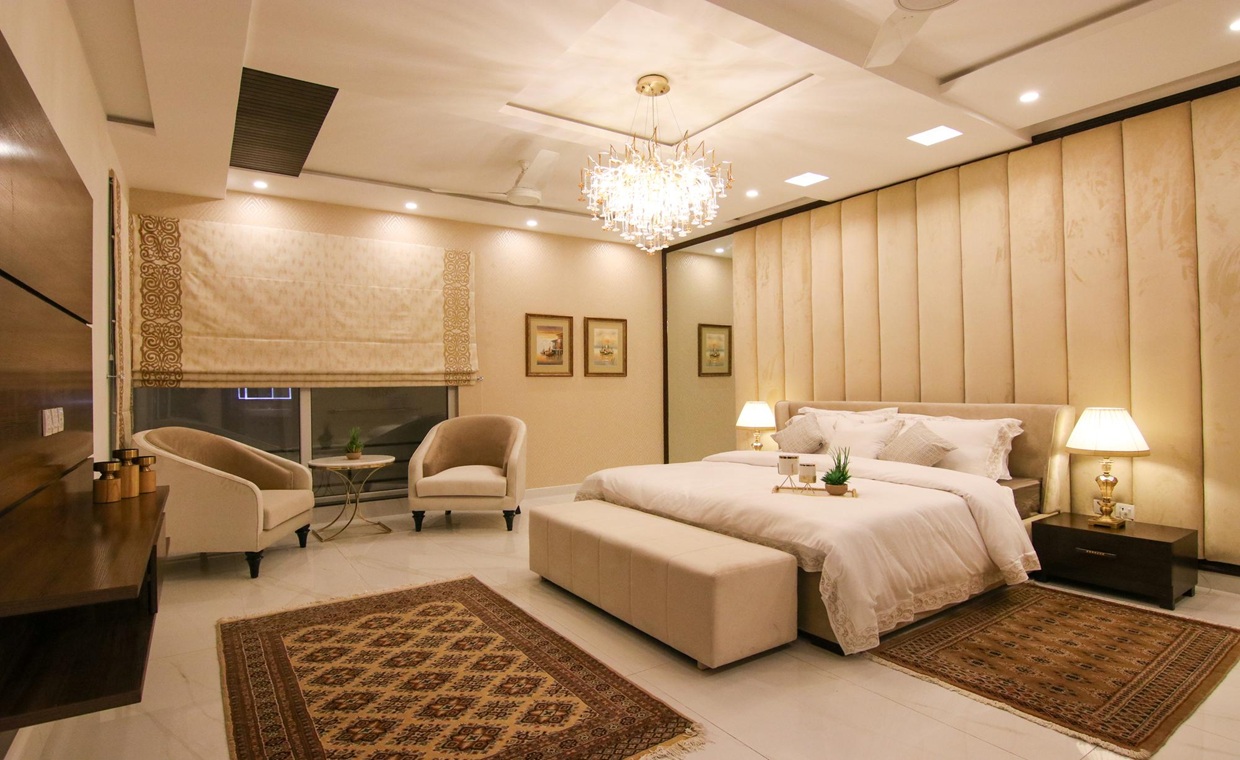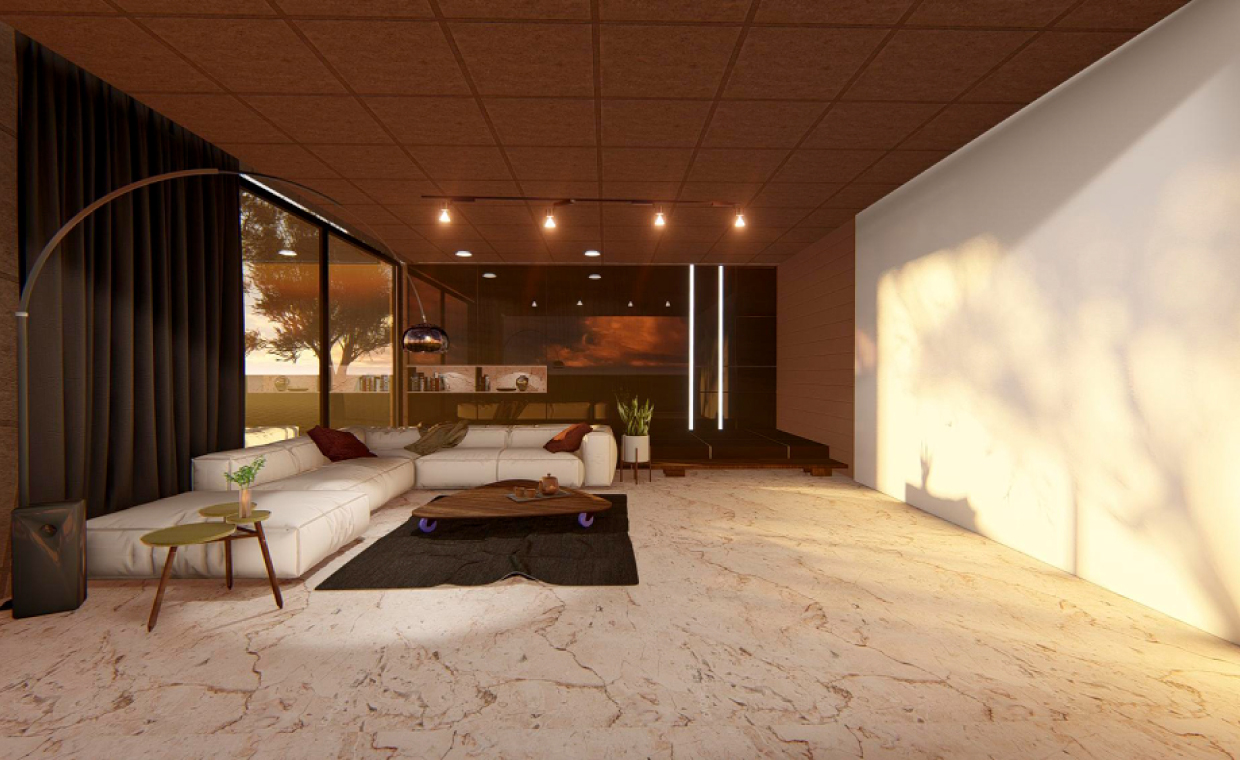
“Buildings are deeply emotive structures that form our psyche. People think they’re just things they maneuver through, but the makeup of a person is influenced by the nature of spaces.”
– David Adjaye
Architecture isn’t just a composition of lines, angles, and volumes. There’s much more that goes into building an experiential space that weighs significantly more than the dimensions of the structure. Spaces have a lot to do with emotions, and they also have an essence that touches your mind. Spirituality and sacredness are the most significant experiences communicated through architecture. Let us learn the connection between spiritual architecture and spaces and dimensions while applying the appropriate architectural design principles.
An example of rich and thoughtful architecture is infused with a soulful experience that goes beyond the physical form of that building. Does this imply that there’s a hidden relationship between architecture and spirituality? Let’s find out through examples of a few structures.
Defining Spirituality in Architecture

“Space has always been the spiritual dimension of architecture. It is not the physical statement of the structure so much as what it contains that moves us.”
– Arthur Erickson
The true meaning of spirituality is discovering your inner self and establishing a relationship with God, your surroundings, and art. It’s more about experiencing a sense of living and learning the true meaning of life. This feeling has existed for many years, and unknowingly, spirituality has formed a deep connection with architecture as well.
Spiritual architecture defines spaces that evoke a sense of being alive and allows users to feel something that soothes their minds. The true essence of spirituality has been ignited in various designs by renowned architects like Tadao Ando, Charles Correa, Louis Kahn, BV Doshi and others. Their projects not only speak a certain design language but the spaces designed by them speak to your mind. The blend of materials and natural environment aids in offering a spiritual experience to the users.
A thoughtful spiritual architecture beholds the power of shaping up as humans by connecting with the built forms, focusing on senses and offering spiritual experience. It further guides the direction of society as a whole. These spaces hold the power to control our minds and resonate at a much deeper level than a vague design. The guiding elements in spiritual architecture are:
The Inner and Outside Connection
A holistically spiritual experience in space isn’t only about the four walls enveloping you or the ceiling above your head. To communicate on a deeper level, there has to be a relation between the site and its surroundings, its present and past, and the cultural context of the place.
Focusing on Senses
Good architecture will make you experience your presence in it. It’s the concept of then and there that makes you aware of the space you are in and establishes a meaningful connection within it. A new-age approach to awakening the senses is through the concept of minimalism that keeps a space decluttered, admirably simple, and makes it easier to perceive it at the moment.
Nature and Buildings
Nature is the ultimate guide when it comes to design. The intricate patterns existing in nature or the earthy accents can effortlessly accentuate the aesthetics of a room and offer a warm experience. When it comes to offering a spiritual experience, the space has to be a beautiful replica of the natural environment, which will offer a one-of-its-kind calming user experience.
12 Examples of Spiritual Architecture
Let’s understand in-depth spiritual architecture through handpicked examples.
01. Matri Mandir, Auroville, India

Nestled in the heart of Auroville is Matri Mandir, which welcomes people from all walks of life. The design of Roger Anger has beautifully succeeded in offering an unparalleled spiritual experience. The design revolved around the concept of representing a mother’s vision in the space.
The facade of this temple is composed of about 1,415 golden discs, which illustrate a cosmic egg. The building is planned with a circular meditation chamber that is accessed via a series of ramps. The interiors are composed of walls clad in white marble and a white carpeted floor. Placed in the center of the room is a crystal globe that receives a single ray of sunlight and leads to a whimsical experience in the room.
02. The Marble Mountains, Danang City, Vietnam

The Marble Mountains are a cluster of five mountains in Vietnam, and each one is named after a natural element. These mountains have many Buddhist and Hindu grottoes dating back to the 19th century. The absence of natural light and the ambiance evoke intense religious feelings within the space, which makes them a classical example of spiritual architecture.
The caves are accessed through stone steps, and this path takes you to the ultimate ambiance that keeps you away from the materialistic life and allows you to know yourself better.
03. Temple for the God of Wealth, Anhui, China

The Temple for the God of Wealth is nestled at the foot of the Dabie Mountains of China. The design was proposed within a natural setting of mountains surrounding the site on three sides. The villagers strongly believe that the temple brings them fortune, which is why the design is the result of careful consideration and thoughtfulness.
The temple is more of a pavilion with its three sides opening up to the view around it and one wall being kept for the deity. The design is a blend of concrete with the local bamboo mats, and the essence is further enhanced with a square skylight allowing natural light.
04. Dilwara Temple, Rajasthan, India

The old temples of Dilwara were constructed during the 11th and 13th centuries and still serve as one of the most significant pilgrimage sites for the followers of Jainism. The design is composed of a simple approach that also encourages focus on the honest reflection of oneself and preaches anti-materialistic values.
It is one of the most intricate and beautiful spiritual structures around the world that follows detailing in each design element. The intricacy led to a total of 14 years of construction for this temple.
05. Cambridge Mosque, Cambridge, England

The cultural richness of the past combined with a modern blend of green technology in the Cambridge Mosque exudes a feeling of timelessness and establishes a relationship with history. The design was envisioned by Marks Barfield Architects, and it mixed British design elements with Islamic architectural features.
The roof of the mosque is supported by timber columns that also serve as a representation of trees. The structure follows the English Gothic style for fan vaulting and skylights have been strategically incorporated to illuminate the spaces with natural light during the daytime. The amalgamation of natural elements within the built environment offers an unmatched spiritual experience to its users.
06. Temple in Stone and Light, Rajasthan, India

Rajasthan is known for its rich culture, vibrancy, and splendid architecture. One such architectural marvel is the Temple of Stone and Light designed by Space Matters. The design offers a contemporary interpretation of the typical Shiva temples in India. While Indian temples are known for their heavy embellishments and intricate detailing, this temple manages to evoke a feeling of devotion and submission to God with its simplicity.
The design has been executed with interlocking stone joinery details and a re-imagination of the typical Shikhar. Natural light enters the hall during the daytime through the interlocking gaps, whereas the interior lighting system extends outside through the same gaps during the night.
The impact of architecture is much beyond your imagination. Let’s have a quick look at the influence architecture has on building design:
07. Water-Moon Monastery, Taiwan

The Water-Moon Monastery, designed by architect Kris Yao, benefits from its rich natural backdrop composed of the Datun Mountains and is planned as a tranquil space enhanced within the natural context.
The structure is designed in exposed concrete with minimal colours painted on the facade. The design is planned with a minimalist approach and is based on the concepts of Zen Buddhism. An 80m-long lotus pond surrounds a series of columns that also offers its mirror image and evokes a sense that this building is floating.
08. Cardboard Cathedral, New Zealand

“The strength of the building has nothing to do with the strength of the material. Even concrete buildings can be destroyed by earthquakes very easily, but paper buildings cannot.”
– Shigeru Ban
The Cardboard Cathedral was conceptualized by Shigeru Ban to serve as a temporary cathedral. The Anglican Cathedral of New Zealand was hit by an earthquake, which led to the proposal of this structure.
This was designed with an approach to keeping it earthquake-resistant. This made the designer compose an A-frame structure with 96 cardboard tubes. While the exteriors are composed of unique and advanced materials, the interiors are magnificently modern and colourful.
09. The Church of the Light, Ibaraki, Japan

The Church of the Light is an architectural marvel designed by Tadao Ando. The design was approached with the concept of extreme minimalism and the architect has wonderfully balanced the solids and voids in the spaces. There’s a harmony between the light and darkness and a single material– concrete takes the lead in curating a soothing user experience.
There’s no ornamentation in the design, and this absence of embellishments jazzes up the user experience as it enables them to focus on their inner path with clarity. The smooth surfaces offer a reflection of light and brighten up the entire space. Further providing a surreal experience is the cross on the east facade that filters the morning light through it.
10. Bosjes Chapel, South Africa

Designed by Coetzee Steyn, the design of the Bosjes Chapel was derived from the natural context existing on site. The mountain terrain inspired the design of the roof with varying levels. The design serves as a re-imagination of the conventional design of Cape Dutch ‘Holbol’ gables.
While the typical approach to the design of a church is introverted to find spiritual reflection, this church drifts away from the notion and rather opens outwards. It looks over the natural views and this approach has also aided in forming a relationship between the design and the site. The plan follows a simple and functional layout and the white interior spaces offer a calming experience.
Here, it is important to know that architecture is all about building geometry, which has to be in harmony with cosmic geometry. It is the rhythm that facilitates this. Let’s know about this in detail:
11. Lotus Temple, South Delhi, India

The Baha’i House of Worship, popularly known as the Lotus Temple is one of the most visited spiritual structures across the globe. This temple is open to everyone and is composed in the form of a lotus flower, which is a symbol of peace, simplicity, freshness, and unity. Fariborz Sahba aimed at achieving all of these through this design.
The nine layers of lotus petals were cast in concrete and clad in white marble. The designer recognized natural elements like light and water as crucial guiding factors in his design. The incorporation of these, along with the geometric patterns, offers a tranquil experience to the visitors and lets them experience spirituality in its true form.
12. Temple of Steps, Nandyala, India

The Temple of Steps beautifully combines its architecture with its surrounding landscaping elements. The design is based on the concepts of simplicity and harmony. The design was inspired by the traditional design of Indian step wells.
“The planning of our temple carries forward the historic precedent of temple plans which addresses the two shrines and the bathing pond for the deity at the entry,” mentioned Sameep Padora about the planning concepts of the Temple of Steps. The design was curated in the local black limestone of Andhra Pradesh, which further strengthens its bond with the site context.
Built Spaces and Spirituality

A well-planned architecture has the power to put an end to the constant quest for peace and spirituality. All it takes is a strategic approach to design that not only offers beautiful aesthetics, but also excellently connects the spaces to the context and rich cultural history. These spiritually built environments can facilitate the feeling of self-awareness and help you discover the ultimate meaning of life.
We hope you loved reading about spiritual architecture and its connection with architecture and spaces. But there’s one more thing that you need to know before you leave, and that is the importance of the sense of a place in architecture. We should not forget our role as humans while designing a structure or home. Here we share a blog on the same:
Sense of Place: Tale of Designing Experiences: Is our Role as an Architect and Human, Different?
Image Courtesy: Image 1, Image 2, Image 3, Image 4, Image 5, Image 6, Image 7, Image 8, Image 9, Image 10, Image 11, Image 12, Image 13, Image 14, Image 15
Author Bio
Saili Sawantt – She is an Architect and Interior Designer by profession. Writing is what she treats as her passion. She has worked as an Architectural Writer, Editor, and Journalist for various design as well as digital portals, both national and international. Formerly she has also worked with Godrej Properties Limited (GPL) Design Studio, Mumbai, due to her keen interested in learning about Sustainability and Green buildings. Apart from this, she runs her blog ‘The Reader’s Express’ and is a practicing Architect & Interior Designer.
































